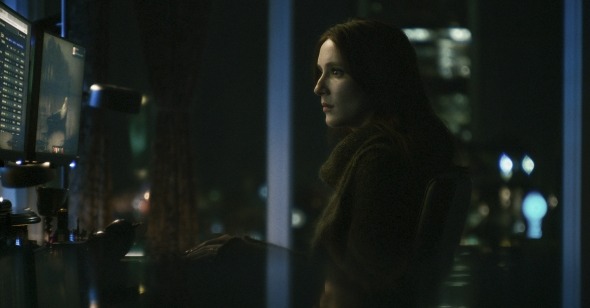Sight Unseen
By Philippa Snow
Red Rooms
Dir. Pascal Plante, Canada, Utopia
In Red Rooms, Canadian director Pascal Plante has produced something of an impossible object: a thoughtful, relatively tasteful film whose plot revolves around the manufacture and distribution of child snuff pornography. If the movie’s thematic fixations arguably mark it as a descendant of the New French Extremity movement of the aughts (albeit one that is strictly French-Canadian, bien sûr), its smooth procedural gloss and morguelike chill make it equally reminiscent of the films of David Fincher and, to some extent, those of Olivier Assayas—such as Demonlover (2002) or Personal Shopper (2016). Its most fascinating asset is its inscrutable protagonist, the dark-web hacker Kelly-Anne, played by the Québécois actress Juliette Gariépy as a figure whose complete and terrifying emptiness is like that of a vacant house where a massacre once occurred.
What is happening—or what has happened—in the obviously haunted space of Kelly-Anne’s mind and body is not something we are privy to, except via subtle context clues. She earns her money as a model, acting as a mannequin onto which others can project whatever image they desire, and by playing online poker, which she favors because she is far better with numbers than she is with people. “I love seeing them lose everything,” she says with casual ease, in a rare moment of personal disclosure that will never be repeated or expanded on. Over the course of Red Rooms, Kelly-Anne watches several people lose a lot more than money, bloodily and horribly, and whether she loves seeing this, too, is not made clear. A mystery wrapped in an enigma wrapped in a VPN, she is an empty avatar of a woman—at once conspicuously beautiful, and inconspicuously blank.
We first see Kelly-Anne camping out on the street like a fan at a concert, hoping for a prime seat at the trial of an alleged child-murderer and snuff-pornographer named Ludovic Chevalier. His crimes are brutal, sexual, and designed to entertain: he is accused of livestreaming the torture and murder of two blonde, affluent, preteen girls on the dark web, in what’s known in urban legend as a “red room.” (This term is made horribly explicable a little later in the film, when we are shown a few frames of the aftermath of Chevalier’s gory, dungeon-splattering handiwork.) A third murder is suspected, but the tape has not been found. Gradually, Kelly-Anne forms a strange partnership with another attendee of the trial: a short, large-eyed hybristophiliac named Clementine who resembles, next to Kelly-Anne, a chihuahua with a crush on a greyhound. Seeing them together, it is clear that Kelly-Anne’s statuesque height and perfect features serve as a smokescreen for her madness—nobody this pretty, Clementine seems to think to herself, could be crazy, and because she isn’t crazy, I’m not either. This illusion is shattered about halfway through the film, when Kelly-Anne reveals that she personally owns copies of the first two Chevalier snuff recordings. She invites Clementine back to her soulless, luxe apartment, and the two women sit down at her computer, bathed in ominous red light, and watch them side-by-side. Clementine weeps softly; Kelly-Anne is as cool and analytical about what they are seeing as a critic at a movie screening.
Kelly-Anne’s interest in the case is, like her affect, both intense and impossible to parse, as demonstrated by a lengthy shot during a courtroom scene in which Gariépy, ostensibly looking at Chevalier, stares straight into the camera, just as Kristen Stewart does in Personal Shopper. As a directorial gambit, breaking the fourth wall only pays off with an actor who is skilled enough, like Stewart or like Gariépy, to hold our gaze without betraying a false thought. Here Gariépy reveals nothing, her eyes as cold and lightless as a pair of switched-off screens. Like Personal Shopper, Red Rooms is a character study in deep disguise as an aestheticized—"elevated,” to evoke an overused phrase, if for some reason you believed that the genre was in need of elevation—horror movie. It’s worth noting that there are no scenes of active violence in the film, though there are touches of unpleasantness throughout: girlish screams on the audio; the rev of a chainsaw; a brief flash of a retainer with a child’s teeth stuck inside it. In eliding the grislier details of the case, Plante pointedly emphasizes the enormous gulf between what the audience is shown and what Kelly-Anne seeks out, and in doing so suggests a hidden world beneath the acceptable voyeurism of the mainstream web. Kelly-Anne is seen watching Chevalier’s videos twice, and both times, the director shoots from the perspective of the screen, so that we ourselves take the place of the snuff. We are Nietzsche’s abyss, gazing back.
As the film progresses, Kelly-Anne’s actions become more hopelessly tinged with a kind of urgent, paraphilic mania; to paraphrase Laura Dern’s wide-eyed Sandy in Blue Velvet (1986), it is hard to figure out whether she is a detective or a pervert. If she truly is a monster, it is also difficult to tell whether she was born one—her inhuman steeliness and preference for numbers over people being a side-effect of something like sociopathy—or made into one by some unspoken formative event: an encounter in her youth, perhaps, with a man a little like Chevalier. When she wins the missing third video in an online auction on the dark web and then watches it alone, it is the only time we see her smile. That she wants this man incarcerated is never in question. Why she cares so deeply remains an insoluble, intriguing mystery. For viewers who are happy to remain in the dark, Red Rooms is a smart, sick thrill—an existential video nasty for the LiveLeak generation.
